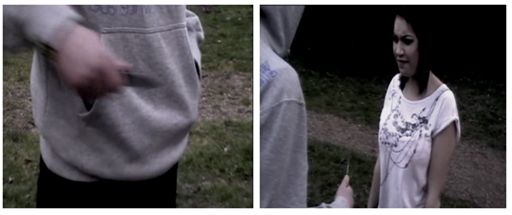We used the 180 degree rule by making sure that all shots during filming were kept on the right side making sure not to cross the line of action as not to disorientate the audience.
Using the rule of thirds was fairly simple because we understood that characters and objects we better placed on the vertical lines which represented the thirds these. The technique that aligning an object with these points creates more tension and interest in the composition than simply putting the person or object in the centre of the screen.
We faced many problems throughout filming, one of which was keeping the 180 degree rule which was kept throughout but from a different view point which made it look odd, so we had to re-film those parts, also lighting was a big factor while filming as most of our original shots were dark and also had to re-filmed. If I were to change anything while filming I would change the initial location where we chose to film because the problems of filming there was that it didn't have a consistency of how many people were there on different days it was either packed or empty making it difficult to get consistent shots throughout.
(00.54 - 01.10) there is a shot in Bad boys 2 which shows how not to break the 180 degree rule while going round in 360 degrees. As long as you show you the audience that there has been a cross past the 180 degree line then the shot is still a consistent shot and should flow perfectly.
(Re-filming a previous shot which failed)
I didn't face many challenges during post-production other than the fact that during editing a few shots that had to be re-filmed due to poor camera work, which in the end wasn't a massive issue. Also I think editing in the amount of time we had to edit the short film was a challenge as I think if i had more time I would have been able to produce a better quality piece of work but in the end it wasn't that bad.

(Me lining up an establishing shot.)
I think that one our strengths were the planning in the beginning and we knew exactly what we had to do during filming. We created a narrative which we thought would be simple but matched what we had to do for the brief, also the fact that it came from a true story made it a little bit easier for us. Another strength that I thought we portrayed in the clip was the camera language and the variety of the different types of shots used.
(An extreme close up of Niraj's mouth)
A weakness of my work I found some parts of the filming because a lot of shots in the end had to be re-filmed more than once but was not a huge dilemma, another weakness I found was the lack of atmosphere created in my particular piece of work which most likely came down to no music being used and not very disciplined editing between shots.
I think that the improvements I would make to my work would be to make sure that every scene was filmed in the same scenario, for example some scene were filmed in the canteen where sometimes it would be very quite and other times where there were people talking, this in editing made it quite hard because it sounded odd when scenes would change and there was a different background sound every time.
















